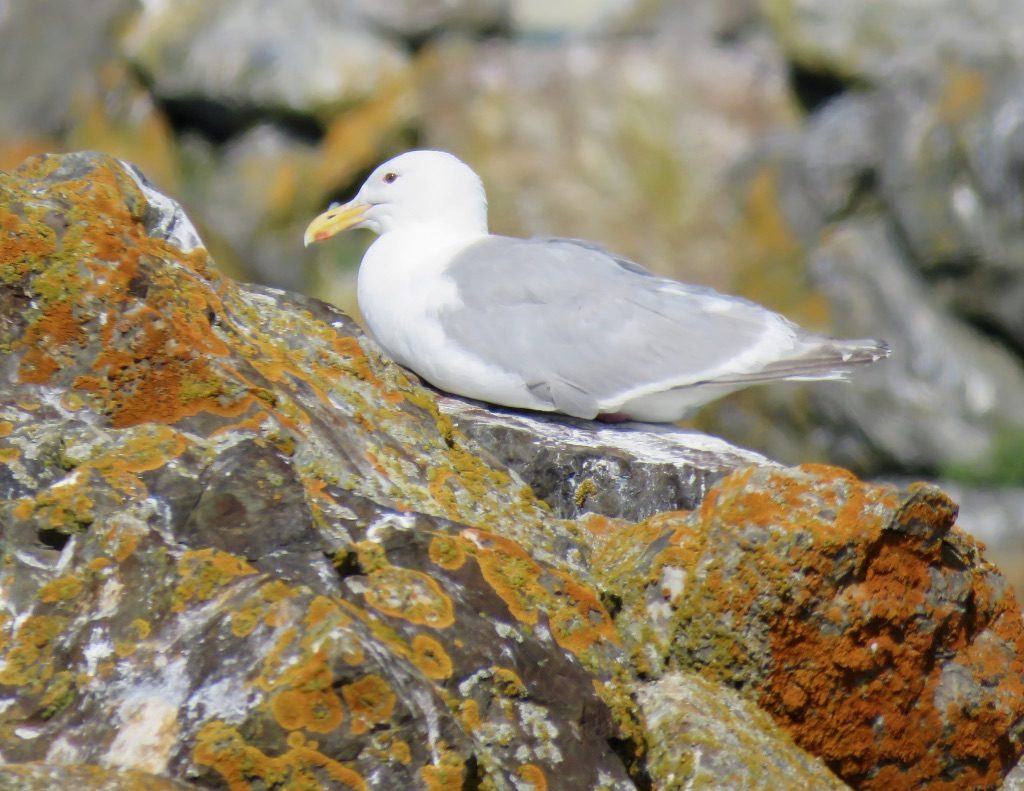
Photo by Michelle Michaud
General Information: The Glaucous-winged Gull (Larus glaucescens) is a common west coast breeder and winter resident found year-round in on the Kenai Peninsula. No sexual dimorphism here – both male and female look alike. They are members of the Order: Charadriiformes (which includes Shorebirds), Family: Laridae (Gulls and Terns)
North America Range
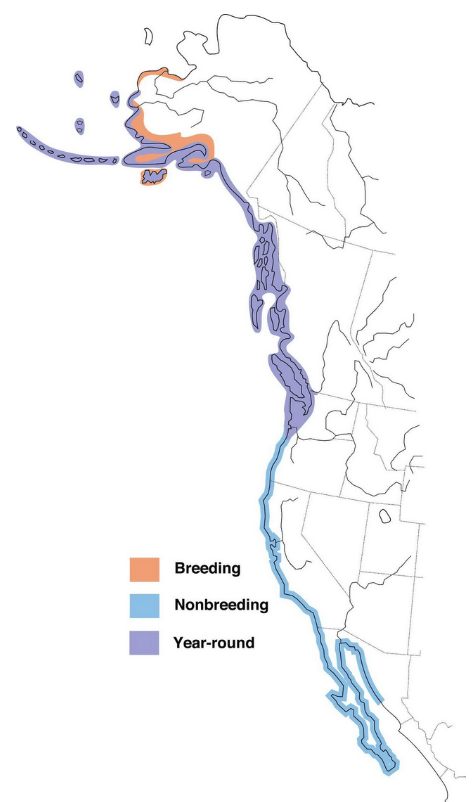
Source: https://www.allaboutbirds.org/guide/Glaucous-winged_Gull/maps-range
Bird Biology:
Characteristics: All ages have pink legs – a good field ID. From there it becomes more difficult as this gull doesn’t reach adult plumage until its fourth year. And, to add to the confusion, there are the breeding and non-breeding plumages (although not that much different). A good field bird book is needed if you want to be familiar with gulls.
Glaucous-winged Gulls are large, ranging in size from 19 -23 inches, and weighing in at around 2.0-2.5 pounds, slightly larger than a Herring Gull, but slightly smaller than a Glaucous Gull.
Adults: Look for a large, stocky gray/silver gull with gray back and gray/silver (not black) wingtips, with white spots near tip. Eyes are dark compared to light eyes on Herring and Glaucous Gulls. Their bill is yellow with some red on lower mandible and don’t forget the pink legs. Breeding birds have an all white head and neck, while non-breeding birds have mottled gray in the head and neck. They are commonly found in pairs year-round, but will forage alone or in large groups.
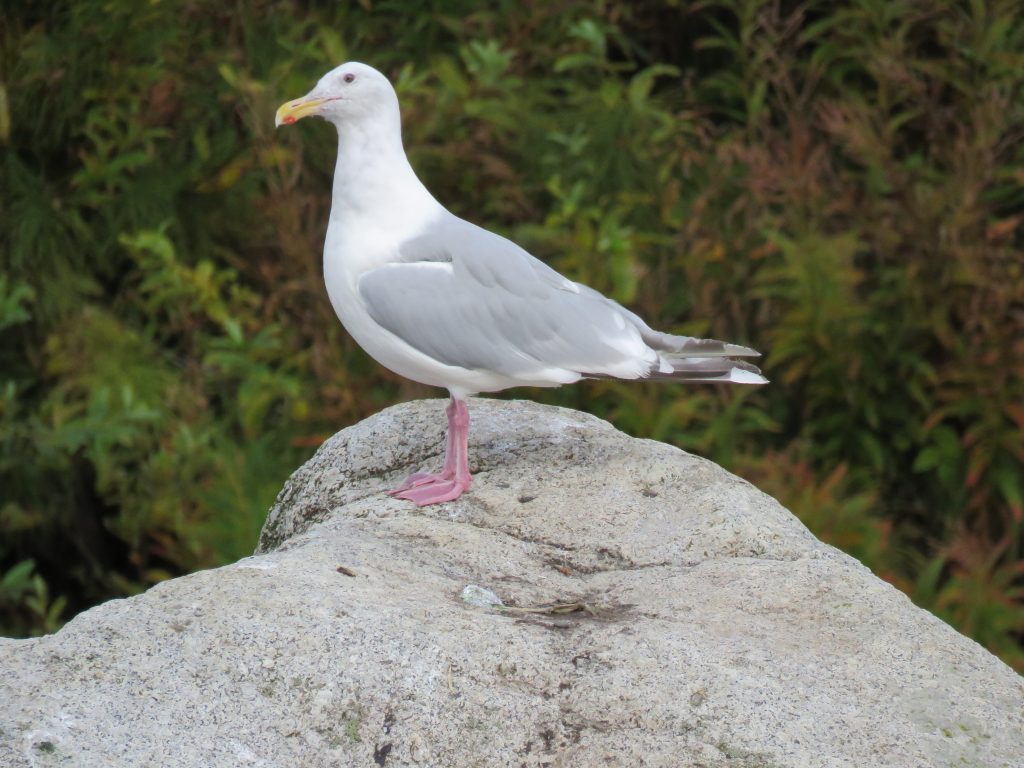
Photo by Michelle Michaud
There are a number of different plumages for birds that have yet to reach sexual maturity. For a description of the different plumages go to: https://www.allaboutbirds.org/guide/Glaucous-winged_Gull/id
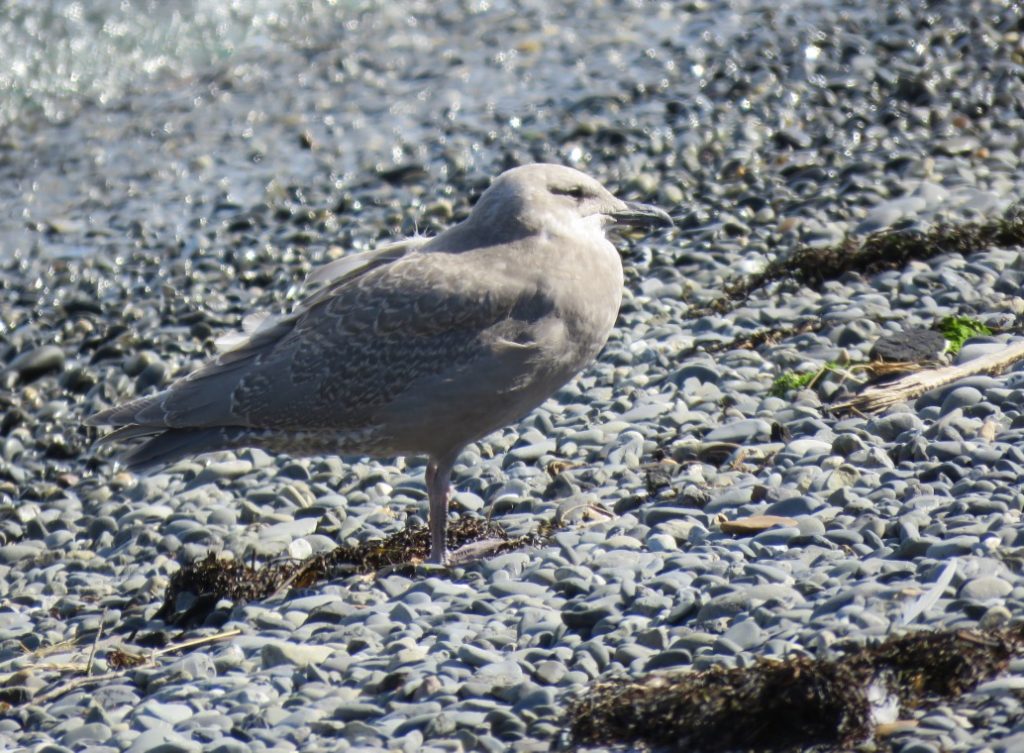
Photo by MIchelle Michaud
Preferred Habitat: Look for the Glaucous-winged Gull near or on coastal water year-round. It prefers good food sources such as bays, inlets, estuaries, beaches, harbors, mud flats, and spends much of the winter loafing on offshore waters and beaches.
In the breeding season, this gull nests on steep coastal cliffs and rocky offshore islands (e.g., Gull Island).
Breeding Season: Begins mid-May to early June, ending in August. Glaucous-winged Gulls do not begin breeding until their fourth year or later and breeds/nests in colonies, sometimes quite dense. As a social breeder, it may breed/nest in colonies with other gull species or seabirds (e.g., puffins, murres).
Nesting: Preference for a nest site is a nest on the ground, rock ledges, and cliffs, but they may nest on suitable buildings or structures. The pair will ‘nest bond’, generally starting several nests, but completing only one nest.
The nest is a bulky cup shape consisting of grasses, seaweed, feathers, fish bones, and other debris (including plastic, unfortunately). The use of plastic by birds is not a good use of “recycling plastic”since the plastic often be ingested or will entangle the nesting bird or chicks.
Eggs and Incubation: Typically 2-3 eggs are incubated by both parents for 26-29 days. Hatchlings are semi-precocial (eyes and ears open, but cannot move about) and downy. The chicks are fed by both parents. The chick’s coloring is cryptic to help camouflage it from predators, including other Glaucous-winged Gulls.
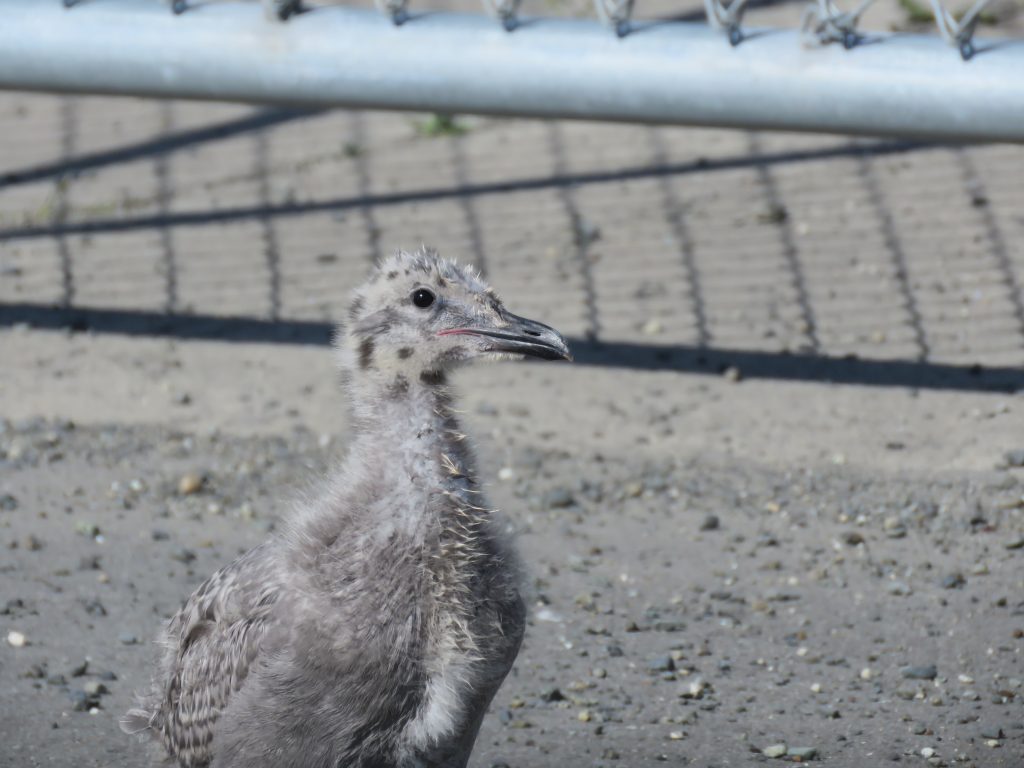
Photo by Michelle Michaud
Fledging: The chicks generally fledge 35-54 days following hatching and will leave the colony about two weeks later to forage on their own.
Food Preferences: Their primary food source is marine invertebrates (limpets, chitons, clams, mussels, squid, crab etc.) and fishes. They will also predate seabird eggs and chicks. They scavenge carrion and will eat food found in landfills and parking lots. Unfortunately people feed gulls, which attracts a lot of gulls in a feeding frenzy. The gulls create a riot as they swoop in to grab the morsel. This human activity is not appropriate and illegal within the City of Homer. Gulls have a notorious reputation of hanging out, in large numbers and in mixed flocks, at landfills seeking food so many birders check out landfills to see if there are any rare gulls present.
Feeding Methodology: These gulls forage at sea, in intertidal areas, along beaches, in parking lots and landfills. When on land they are ground foragers. They take prey from the surface of water or may perform a dramatic plunge into water from the air. They will try to harass and steal food from other birds, such as cormorants.
Roosting: They a social roosters with beaches a favorite roosting spot but they can also be found roosting on pilings, guardrails, lamp posts, parking lots, and in fields or dumps

Photo by Michelle Michaud
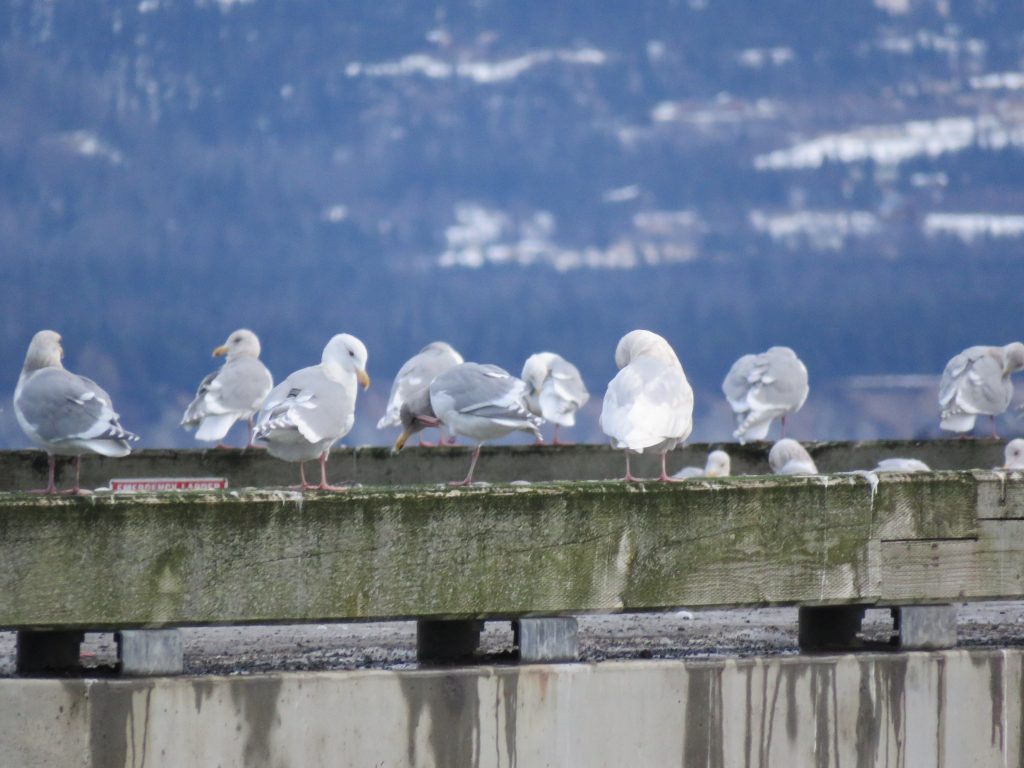
Photo by Michelle Michaud
Migration: Not all Glaucous-winged Gulls migrate as many northern birds are year-round residents, moving with the food resources. For those that do migrate, spring migration is from late February to early May. Fall migration is from late August to late November. They may migrate as far south as northwestern Mexico but are rarely found inland, preferring a coastal environment.
Vocalizations: This bird’s call is a “keow” whistle. If an intruder approaches you will here the ‘ga, ga’ notes. I think that is one we’ve all heard and is most familiar.
Threats: Fishing line and hooks are deadly as Glaucous-winged Gulls are opportunistic scavengers and can ingest a hook or get entangled. So if you see fishing line and hooks on the ground, pick them up and dispose of them properly. And if you are out fishing, do not discard these items onto the ground or from your fishing boat.
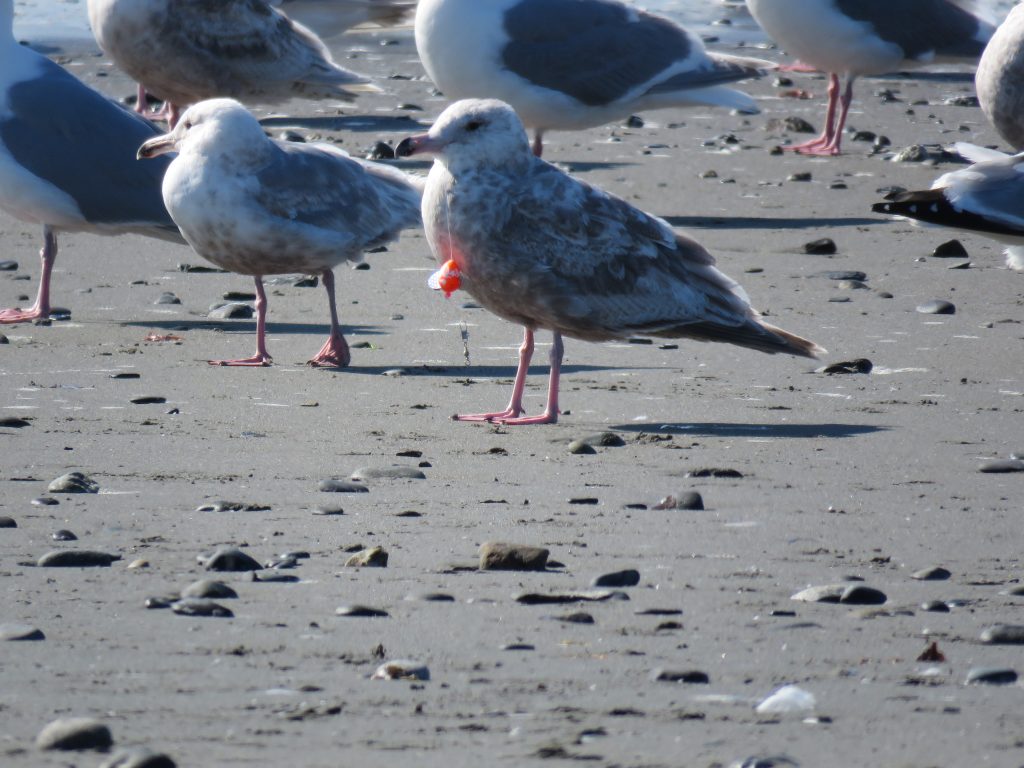
Photo by Michelle Michaud
Fun Facts:
- This bird hybridizes with the Herring Gull, Western Gull, and Glaucous Gull. The young may possess physical characteristics of both parents.
- Gulls are often difficult enough to identify, especially before they reach sexual maturity, but added to that is the fact that they often inter-breed and hybridization makes field identification more difficult. Pete Dunne recommends that if you find a gull with “… a mixed array of traits, consider the very possibility that it’s a hybrid” and either try to tease out what the bird is or move on to another gull.
- This is the one of five North American Gulls that does not have black on its wing-tips.
Conservation Status:
Audubon Alaska has identified the Glaucous-winged Gull species as a common species that is declining or vulnerable, thereby warranting species conservation attention. It is estimated that 44% of the bird’s population resides in Alaska making it at-risk for climate change and other environmental influences.
The International Union for Conservation of Nature and Natural Resources (IUCN) has identified the population of the Glaucous-winged Gull as increasing, with no genuine threats to the global population estimated at over 570,000 individuals.
Similar Species in Alaska: Glaucous Gull, Herring Gull
Sources of Information:
All About Birds. Cornell Lab of Ornithology. Downloaded on January 10, 2019 at https://www.allaboutbirds.org/guide/Glaucous-winged_Gull/id
Baicich, Paul J. and Harrison, Colin J.O. 1997. Nests, Eggs, and Nestlings of North American Birds, 2nd Edition. Princeton Field Guides.
BirdLife International 2018. Larus glaucescens. The IUCN Red List of Threatened Species 2018: e.T22694334A132543276. http://dx.doi.org/10.2305/IUCN.UK.2018-2.RLTS.T22694334A132543276.en. Downloaded on 10 January 2019.
Dunne, Pete. 2006. Pete Dunne’s Essential Field Guide Companion: Comprehensive Resource for Identifying North American Birds. Houghton Mifflin Company.
Lucas DeCicco/McCaulay Library/Cornell University Ornithology Lab (ML174609).
National Audubon Society. Audubon: Guide to North America Birds. Downloaded on January 10, 2019 at: https://www.audubon.org/field-guide/bird/glaucous-winged-gull
Todd, Frank S. 1994. 10,001 Titillating Tidbits of Avian Trivia. Ibis Publishing Company.
Warnock, N. 2017. The Alaska WatchList 2017. Audubon Alaska, Anchorage, AK 99501. Downloaded on January 10, 2019 at: http://ak.audubon.org/sites/g/files/amh551/f/annotated_watchlist_common_decline_2017.pdf
The gallery was not found!